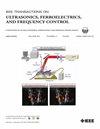Contrast-Enhanced Structured Illumination Ultrasound Imaging (CE-SIU)
IF 3.7
2区 工程技术
Q1 ACOUSTICS
IEEE transactions on ultrasonics, ferroelectrics, and frequency control
Pub Date : 2025-08-28
DOI:10.1109/TUFFC.2025.3603281
引用次数: 0
Abstract
Super-resolution ultrasound (SRUS) technology based on contrast agents has shown great potential in in vivo microvascular blood flow imaging and has become a hot topic in the industry in recent years. SRUS represented by ultrasound localization microscopy (ULM) eliminates the point spread function (PSF) caused by diffraction by localizing sparse microbubbles in the image, and then constructs a super-resolution blood flow structure map through long-term image accumulation. It is worth mentioning that almost all current super-resolution strategies, including ULM, adopt postimage processing strategies. In optics, in addition to postimage processing super-resolution techniques, the design of the illumination light field is also a popular super-resolution imaging method. This inspired us to design the acoustic field to achieve a super-resolution blood flow imaging strategy based on structured acoustic field illumination. In this article, we propose a new structured acoustic field illumination design method, which achieves 2-D structured acoustic field design by improving the acoustic field calculation of Gerchberg–Saxton algorithm (GSA) based on Talbot effect. At the same time, we have designed a corresponding structured acoustic field reconstruction strategy that can adaptively reconstruct any structured illumination method, and the reconstructed image frame rate is comparable to that of multiangle plane wave. Combined with image postprocessing methods, we have obtained contrast-enhanced structured illumination ultrasound (CE-SIU), which reduces the full width at half maximum (FWHM) of the microbubble PSF, breaking through the lateral resolution limit of contrast-enhanced imaging. The super-resolution strategy based on acoustic field design proposed in this study provides new insights and perspectives for the development of the overall technical route of SRUS.对比增强结构照明超声成像(CE-SIU)。
基于造影剂的超分辨率超声(SRUS)技术在体内微血管血流成像中显示出巨大的潜力,成为近年来业界研究的热点。以超声定位显微镜(ULM)为代表的SRUS通过定位图像中的稀疏微泡,消除衍射引起的点扩散函数,然后通过长期的图像积累构建超分辨率血流结构图。值得一提的是,目前包括ULM在内的几乎所有超分辨率策略都采用了图像后处理策略。在光学领域,除了图像后处理超分辨率技术外,照明光场的设计也是一种流行的超分辨率成像方法。这启发我们设计声场,以实现基于结构化声场照明的超分辨率血流成像策略。本文提出了一种新的结构化声场照明设计方法,通过改进基于Talbot效应的Gerchberg-Saxton算法的声场计算,实现二维结构化声场设计。同时,我们设计了相应的结构声场重建策略,可以自适应重建任何结构照明方法,重建图像帧率与多角度平面波相当。结合图像后处理方法,我们获得了对比度增强结构照明超声(CE-SIU),该方法减小了微泡点扩散函数(PSF)的半最大值全宽度(FWHM),突破了对比度增强成像的横向分辨率极限。本研究提出的基于声场设计的超分辨率策略为sru整体技术路线的发展提供了新的见解和视角。
本文章由计算机程序翻译,如有差异,请以英文原文为准。
求助全文
约1分钟内获得全文
求助全文
来源期刊
CiteScore
7.70
自引率
16.70%
发文量
583
审稿时长
4.5 months
期刊介绍:
IEEE Transactions on Ultrasonics, Ferroelectrics and Frequency Control includes the theory, technology, materials, and applications relating to: (1) the generation, transmission, and detection of ultrasonic waves and related phenomena; (2) medical ultrasound, including hyperthermia, bioeffects, tissue characterization and imaging; (3) ferroelectric, piezoelectric, and piezomagnetic materials, including crystals, polycrystalline solids, films, polymers, and composites; (4) frequency control, timing and time distribution, including crystal oscillators and other means of classical frequency control, and atomic, molecular and laser frequency control standards. Areas of interest range from fundamental studies to the design and/or applications of devices and systems.

 求助内容:
求助内容: 应助结果提醒方式:
应助结果提醒方式:


